What is Jimmy Goldstein's net worth?
Jimmy Goldstein is an American real estate developer and NBA superfan who has a net worth of $200 million. Jimmy Goldstein has previously estimated his net worth to be "in the ballpark" of $100 million. However, that net worth does not include the value of his famous home, the Sheats-Goldstein Residence. That residence is worth AT LEAST $50 million, perhaps more like $100 million, considering its celebrity and icon status. While he's alive, we include the value of the home when calculating Jimmy Goldstein's net worth. As we detail later, upon his death, the home will be donated to the LA County Museum of Art.
Jimmy Goldstein earned a fortune thanks to real estate in California, primarily mobile home parks around the cities of Carson and Palm Springs. His mobile home park empire likely generates tens of millions per year in passive rental income.
Outside of his real estate fortune, Goldstein is famous for attending NBA games in colorful and eccentric outfits. He attends over 100 NBA games per season and has attended nearly every NBA Finals game since the early 1990s. Known for his flamboyant, fashion-forward courtside outfits and for being accompanied by much younger model companions, Jimmy is considered the most recognizable non-player figure in the NBA.
He is also known for owning the Sheats-Goldstein Residence in Los Angeles, which has been used in many films, TV shows, and photo shoots. The Sheats-Goldstein Residence was one of the primary filming locations in the 1998 movie, "The Big Lebowski."
Early Life
James F. Goldstein was born on January 5, 1940, in Milwaukee, Wisconsin, to Nanette and C. Ellis Goldstein. His father owned a department store in Racine called Zahn's. Jimmy would later attribute his flashy clothing as a backlash against his father's stodgy and formal dressing habits.
Wisconsin was home to famed architect Frank Lloyd Wright. There are three Frank Lloyd Wright properties in Racine, Wisconsin. This is how Jimmy was exposed to and became passionate about architecture.
As a kid, Jimmy became enthralled by basketball. At the age of 15, he was hired by the Milwaukee Hawks to sit courtside and keep game stats. Describing this experience decades later:
"Once I did that and sat courtside for the games, I was totally hooked. My entire life has been devoted to professional basketball since then. I have such a passion for the game. I think there's more athleticism displayed in basketball than in any other sport."
Jimmy played basketball at Nicolet High School and then enrolled at Stanford University, where he studied mathematics and physics. He then earned an MBA at UCLA. According to legend, during his time at UCLA, Jimmy was engaged in a 6-month affair with actress Jayne Mansfield, who was not only eight years his senior but also married at the time to bodybuilder Mickey Hargitay.
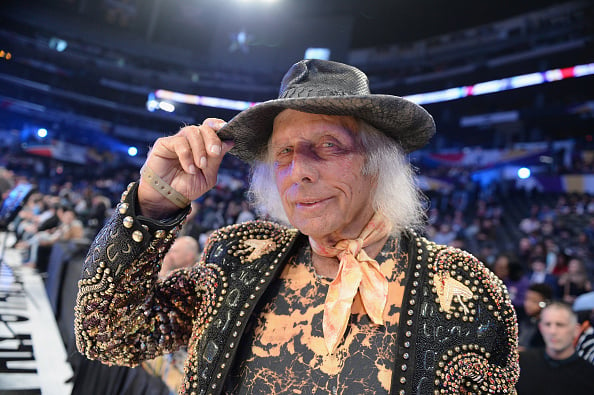
Getty
Mobile Home Empire
After graduating from UCLA in 1964, Jimmy joined a company called Rammco Investment Corporation. Rammco made a fortune in the late 1960s by buying cheap farmland on the outskirts of LA and then developing it into neighborhoods. Jimmy's job was to find acquisition targets in Riverside and San Bernardino.
Through this job, Jimmy was exposed to the surprisingly lucrative world of mobile home park ownership. In the early 1980s, Jimmy formed his own real estate investment company and set about acquiring properties.
Today, he reportedly owns at least a dozen mobile home parks in both Northern and Southern California. The rental income from these properties is Jimmy's primary source of income. For example, in 2007, he bought a mobile home park in Carson, California, for $23 million, using $18 million worth of financing.
Controversial Loophole
Jimmy has stirred controversy with his management style at some of these mobile home parks. Mobile home parks are typically rent-controlled, but Jimmy has consistently fought to raise rents at his properties. In fact, some have even claimed that for years, Jimmy employed a strategy of buying rent-controlled properties and then using a legal loophole (that has since been closed) to essentially force tenants out so he could raise the rents. That legal loophole allowed landowners to subdivide their properties into separate cities. Triggering that law, which dated back to 1893, left tenants with three options:
- Buy their properties.
- Pay the higher rent.
- Leave.
If they chose to move out, he raised the rent. Frequently, people living in mobile homes were not able to purchase their property outright, and banks are sometimes unwilling to offer mortgages for mobile homes. Furthermore, people who live in mobile homes are also not typically able to absorb a sudden increase in rent. As a result, the tenants often felt Jimmy was pulling the rug from under homes they had owned for years. From Jimmy's point of view, rent control often results in his tenants paying a fraction of the market rate, and many of the tenants can easily afford an increase.
A notable lawsuit involved the city of Carson, California, near LAX airport. Jimmy's legal battle with Carson lasted from 2005 to 2015. The city reportedly spent more than $3 million on legal fees fighting Jimmy over the years. In the end, the suit went all the way up to California's State Supreme Court, which actually sided against Goldstein. On the other hand, Jimmy does apparently take very good care of his parks.
Mobile Home Park Estimated Income
Some of the parks in his portfolio have included:
- El Dorado Mobile Country Club in Palm Springs (377 spaces, est. $301,600/month in gross rent)
- Carson Harbor Village in Carson (420 spaces, approx. $347,340/month)
- Colony Cove Mobile Estates in Carson (420 spaces, approx. $318,360/month)
From these three parks alone, Goldstein generates nearly $1 million per month in gross rent. He is believed to own at least 20 similar parks, which would put his monthly gross rental income near $6.5 million, or $77 million per year. Assuming a conservative 50% profit margin, his mobile home empire likely earns him over $3 million per month in net income, or more than $38 million per year in profit.
Jimmy's business card reads:
- Fashion
- Architecture
- Basketball
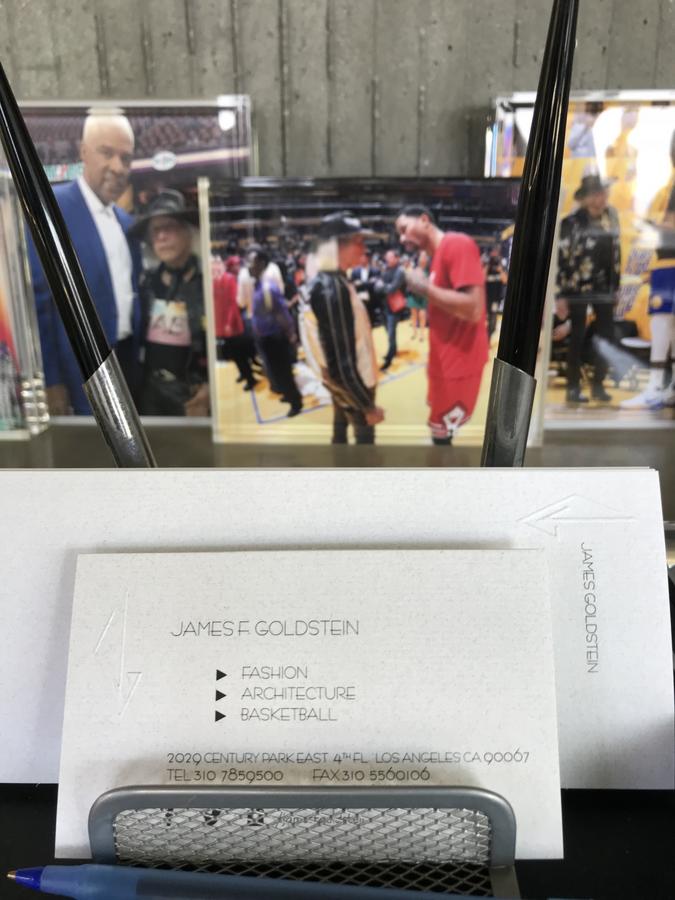
Jimmy Goldstein's business card
NBA Super Fan
Jimmy Goldstein is probably most famous for being a permanent fixture at NBA games, where he is seen in the best seats wearing extremely gaudy outfits. He typically attends over 100 games a season, both in his home state of California and all around the country. He can be seen on the sidelines, usually wearing outrageous outfits. His outfits are best described as "cowboy couture" and are made by designers such as John Paul Gaultier and Roberto Cavalli.
Jimmy reportedly spends over $500 thousand every year to purchase sports tickets and travel to games. He has season ticket floor seats at both the LA Lakers and LA Clippers games. He has not missed an NBA Finals game since the early 1990s.
Interestingly, despite living in Los Angeles and having courtside seats to the Lakers, he is famously NOT a Lakers fan.
As the late NBA commissioner David Stern once stated:
"He probably has the largest investment of any fan in America, so we get a kick out of him. He has got quite a flair and we love him as sort of a superfan."
After donating a substantial amount of money to the Naismith Memorial Basketball Hall of Fame, there is now an exhibit named in his honor. The "James E. Goldstein SuperFan Gallery" is dedicated to celebrating the NBA's most iconic fans.
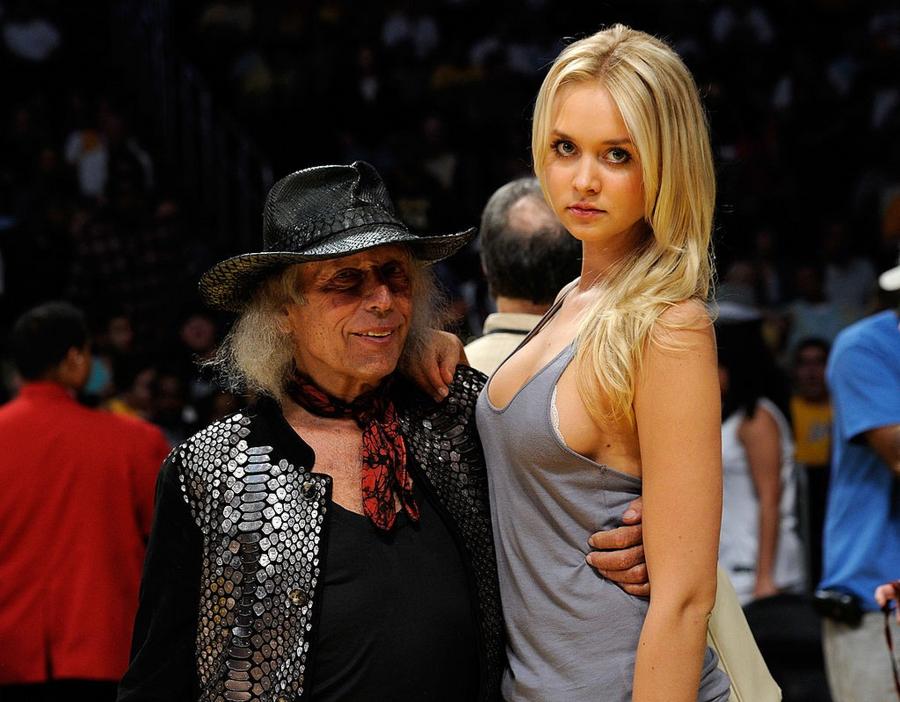
Kevork Djansezian/Getty Images
Jimmy Goldstein's Big Lebowski House
Jimmy is also famous for owning an opulent house in the Hollywood Hills that has been featured in many movies and TV shows, notably the McG-directed "Charlie's Angels: Full Throttle" and "The Big Lebowski." In "The Big Lebowski," the home was the residence of porn king Jackie Treehorn. The home is rented out multiple days a week for commercial and fashion shoots.
The house, which is called the "Sheats-Goldstein Residence," was designed by noted architect John Lautner. As we stated earlier, Jimmy grew up around Frank Lloyd Wright homes in Wisconsin, particularly Racine. Lautner was one of Lloyd Wright's protégés.
The Sheats Goldstein Residence was designed between 1961 and 1963, and construction began in 1963. The residence was built for Helen and Paul Sheats and their five children. The design is one of the most well-known and celebrated examples of American Organic Architecture.
The home was designed from the inside out, and the exterior structure is built directly into the surrounding landscape in such a way that it is an extension of the environment around the home. Rather than leveling the surrounding rocks and vegetation, a practice that is common in most building projects, Lautner absorbed the landscape into the design itself, solving any structural issues through architectural adaptations as he went along. The result is a truly striking and one-of-a-kind home. The house has five bedrooms, four and a half bathrooms, and a living room that opens out onto a large terrace.
When the home was first constructed, the living room and the outdoor terrace were only separated by forced air. There was no actual wall. The original structure also features windows that look directly into the pool behind the house. This allowed Mrs. Sheats to keep an eye on her children in the pool while she worked in her studio, which was below ground level.
The Sheats eventually moved on, and two other people subsequently owned the home. By the late 1960s, it was empty and decaying.
Jimmy Goldstein purchased the home in 1972. He had been living in a high-rise apartment, and he wanted to find a more comfortable home for his Afghan hound, Natasha.
He paid $182,000 in 1972 for the home. That's the same as around $1.3 million today. In the 1990s, he paid $800,000 for the home next door. He proceeded to demolish that property and replace it with an entertainment complex that features a tennis court on the surface level and a nightclub/office on the underground level. The entertainment complex wasn't complete until 2016. If the home were ever offered for sale today, which is no longer possible, as we'll explain in a moment, the Sheats-Goldstein residence would easily be worth well over $50 million.
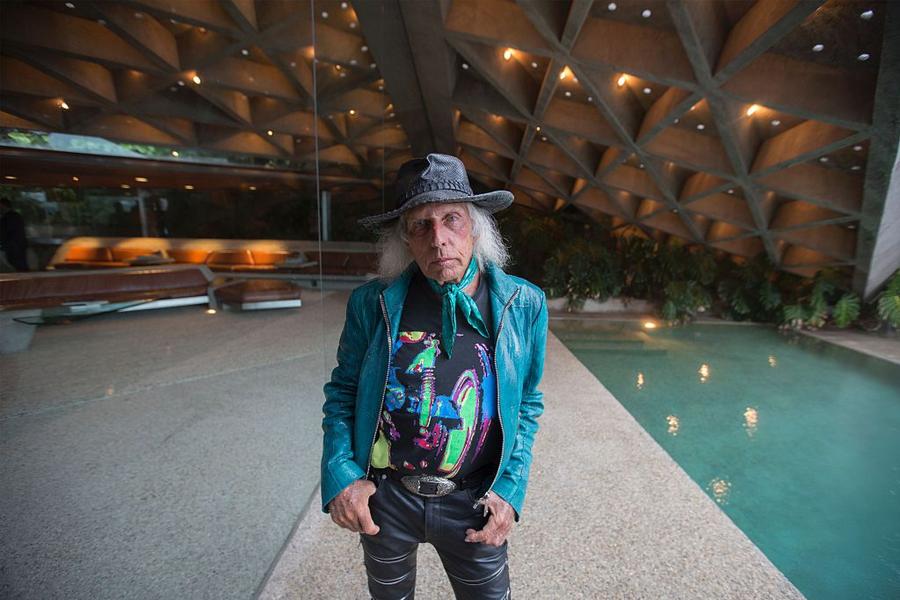
DAVID MCNEW/AFP/Getty Images
To salvage the decaying mansion, after buying the mansion, Jimmy rehired John Lautner to expand on the original design, and over the next 20 years, they did their best to make the house as perfect as they could. Jimmy would later say in an interview:
"It was never my goal to bring the house back to where it was originally because it wasn't perfect originally. My goal was to make it perfect."
Lautner and Goldstein worked on the house over the years, adding invisible glass walls, retractable skylights, and custom concrete furniture in keeping with the overall modern minimalist style. The architect also added several unique touches, including a reflecting pool walkway and a glass sink with no visible faucet. Goldstein also decided to set off the minimalist concrete building by planning a jungle of tropical plants around the home and property.
Renovations continued despite the fact that Lautner passed away in 1994.
Over time, he also acquired nearby lots to create a four-acre private jungle in the middle of prime Beverly Hills.

via Brian Warner

via Brian Warner

Via Brian Warner
In addition to the home itself, there is also an art installation that sits on the hill just below the structure, designed by James Turrell. The installation, called "Above Horizon," was commissioned by Jimmy. It was meant to be a collaboration between Lautner and Turrell, but Lautner passed away before the installation was fully underway. "Above Horizon" features a room with portals and a concrete lounge. Every evening, the room turns into a mind-boggling sky and light show created by thousands of LED lights.
The property has an "infinity tennis court" on a connected lot that overlooks the Los Angeles skyline.
Directly below the tennis court is an underground, fully functioning nightclub called "Club James." The club has hosted many, many celebrities. Rihanna held her 27th birthday party there, featuring attendees such as Mick Jagger, Leonardo DiCaprio, and many more.
As we stated previously, if the Sheats Goldstein Residence were ever put on the open market, the property would likely be worth north of $100 million. But, as you're about to learn, that will never happen…
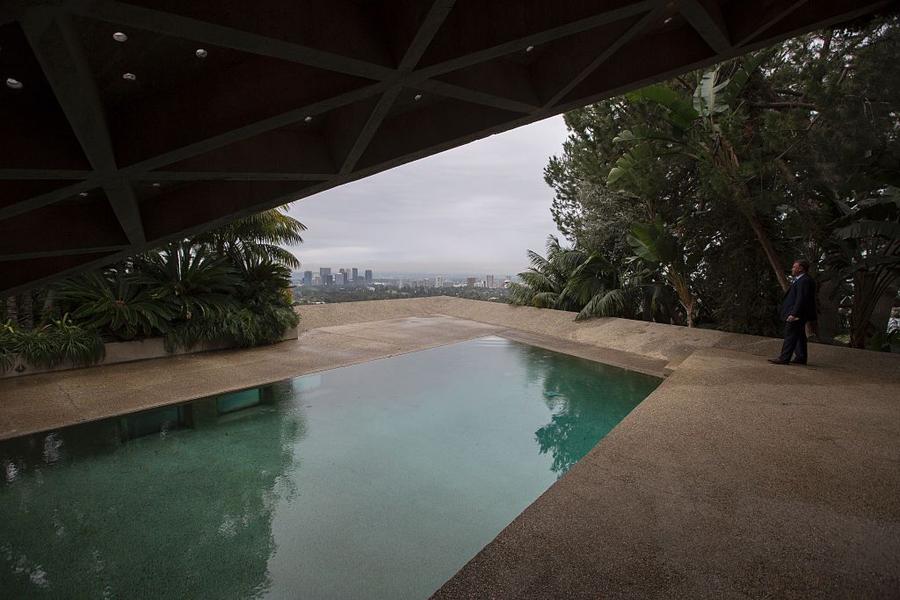
DAVID MCNEW/AFP/Getty Images
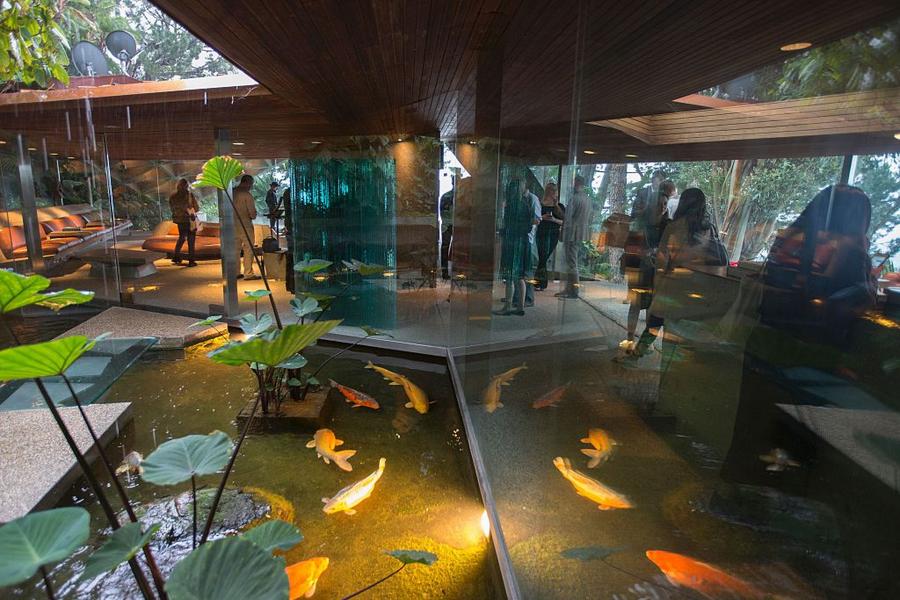
DAVID MCNEW/AFP/Getty Images
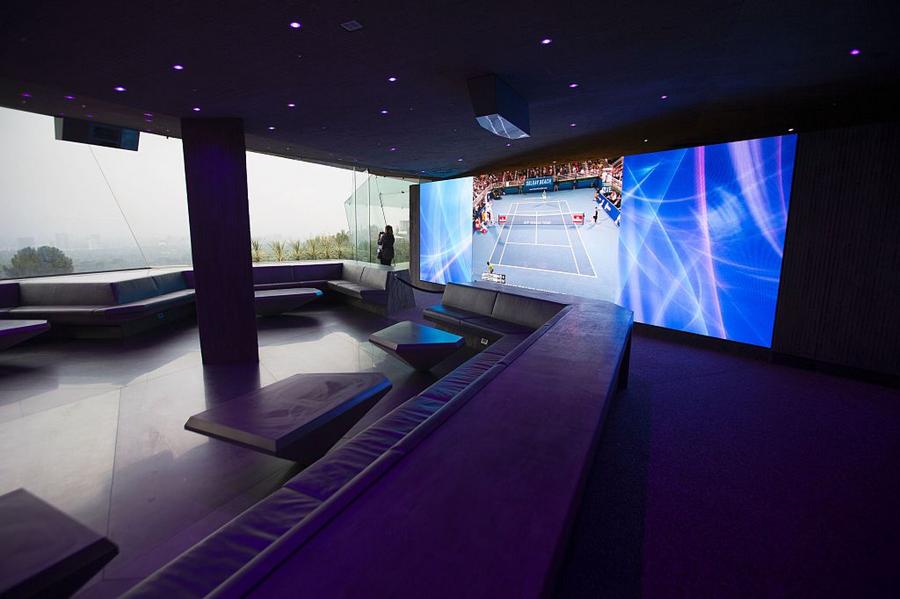
DAVID MCNEW/AFP/Getty Images

DAVID MCNEW/AFP/Getty Images
Sheats-Goldstein Residence Donation
If you were thinking of buying the Sheats-Goldstein someday, unfortunately, that's not gonna happen. In 2016, Jimmy Goldstein announced he had reached a deal to donate his famous house to the Los Angeles County Museum of Art ("LACMA") upon his death.
In addition to donating the actual residence, Jimmy had to donate an additional $17 million trust fund to cover ongoing maintenance for the property after his death.
The donation is the first of its kind for LACMA and includes not only the home and the interior furnishings but several other buildings on the property, as well as Goldstein's private art collection and other items. Although the donation will not fully go into effect until after Goldstein's death, LACMA plans to begin hosting limited tours and other events in the home. LACMA is planning to eventually use the space for fundraisers and exhibits to showcase the home's unique architectural characteristics and educate the public about Los Angeles's rich architectural history.
/2009/12/Jimmy-Goldstein.jpg)
/2010/07/Pat-Riley.jpg)
/2010/12/Byron-Allen2.jpg)
/2017/03/GettyImages-117034877.jpg)
/2020/04/michael.jpg)
/2017/08/flw.jpg)
/2009/09/Jennifer-Aniston.jpg)
/2020/06/taylor.png)
/2020/02/Angelina-Jolie.png)
/2018/03/GettyImages-821622848.jpg)
/2019/10/denzel-washington-1.jpg)
/2009/11/George-Clooney.jpg)
/2020/01/lopez3.jpg)
/2009/09/Brad-Pitt.jpg)
/2019/04/rr.jpg)
/2009/09/Cristiano-Ronaldo.jpg)
:strip_exif()/2015/09/GettyImages-476575299.jpg)
/2009/12/Jimmy-Goldstein.jpg)
/2017/08/flw.jpg)
/2025/06/jimmy.png)
/2010/07/Pat-Riley.jpg)
/2016/04/trump.jpg)
/2011/01/GettyImages-456477386.jpg)
/2025/05/quincy-jones-bel-air.png)
/2021/09/Wilt-Chamberlain.jpg)
/2017/02/GettyImages-528215436.jpg)
/2019/11/GettyImages-1094653148.jpg)